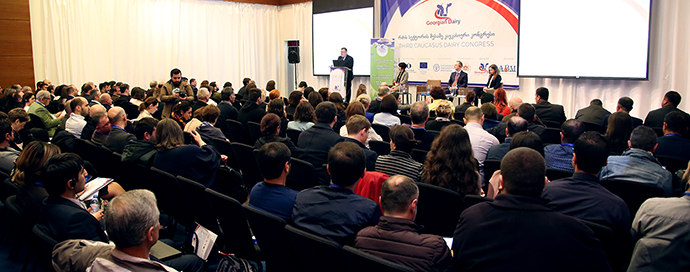Supporting dairy in Georgia

More than 200 commercial dairy farmers, processors, equipment suppliers, industry experts, and government representatives met in Tbilisi today for Georgia’s annual dairy congress.
This, the fifth edition of the congress, was organized by the European Bank for Reconstruction and Development (EBRD) and the Food and Agriculture Organization of the United Nations (FAO) with support from the Ministry of Environmental Protection and Agriculture of Georgia and the European Union in Georgia via the EU4Business initiative.
Vincent Rey, the Head of Cooperation, the European Union Delegation to Georgia said: “We have a number of projects to assist Georgian producers in meeting EU standards and in many cases quality and hygiene standards are being raised.”
Staying competitive
The joint EBRD-FAO project is aimed at assisting Georgian SMEs in adapting to the challenges brought about by increased competition in the local market. As a result, all players along the dairy chain in Georgia need to raise the safety and quality standards of their products and differentiate them in national and export markets.
Nina Kuzmina from EBRD’s Agribusiness Department said, “Improving the quality and safety of products and increasing efficiency are key to staying competitive in the dairy sector. We are assisting through knowledge sharing, targeted advice and by supporting the expansion of commercial milk producers’ capacities, but there are still too few producers to reverse existing negative market trends.”
Andriy Yarmak, FAO economist added, “One of the major problems in Georgia is the lack of educated dairy professionals: veterinarians, feed crop production agronomists and nutritionists. Georgia would greatly benefit from good university programmes in these areas, which would educate students in all elements of modern production technologies.”
A rise in milk production
Since the project’s launch in 2015, the production of high quality milk in Georgia has more than doubled, and most of the commercial producers have been assisted by the EBRD and FAO.
According to Levan Davitashvili, Minister of Environment Protection and Agriculture of Georgia, “Through our joint efforts, governmental policy is already stimulating local milk production, and with the support of international organizations we’re managing to raise consumer awareness of the high quality of the Georgian milk.”
The Georgian Dairy Association also intends to conduct a campaign to promote local milk and its products and further increase consumer awareness in order to increase demand for raw milk as a healthy product. The safety and quality of Georgian milk is relatively low due to the lack of knowledge and capacity on modern approaches to production and handing. To boot, consumers are not aware of the food safety risks related to home-made dairy products and buy them in much larger quantities than from officially registered dairies.
A survey, conducted by the Georgian Dairy Association, also discussed at the congress, highlighted seasonality and the limited quantity of milk as one of the main challenges for the dairy sector. Increasing the number of commercial farms and was cited as on possible solution to remedy these problems.
Environmental focus
One session focused on the environmental impact of the dairy sector, and in particular on mitigation measures. Dairy production is a significant source of greenhouse gas emissions and as such sustainable farming systems should comprise appropriate waste management services, water management services and be mindful of land degradation.
The EBRD and FAO promote low carbon livestock, and increasing productivity is one way of reducing emissions per litre of milk produced.
Antibiotic residues in milk and the risk to consumers was also discussed in a context in which there is a drive to improve customer confidence in Georgian dairy.
Also at the congress, FAO and the Georgian Dairy Association presented awards to two local journalists, from the Georgian Public Broadcaster and Imedi TV, for the Best Media Products focusing on the dairy sector. These were TV stories on the implementation of the National Animal Identification and Traceability System in Georgia, and zoonotic diseases transmitted from animals to humans.
Another EBRD-FAO project is focusing on developing Geographical Indicators (GIs) – quality labels that link products to their area of production – in the Georgian dairy sector. Given the wealth of traditional food products in Georgia, the EBRD and FAO are working to strengthen producer organizations to promote and protect many products, including two cheeses: Sulguni and Tushetian Guda.
